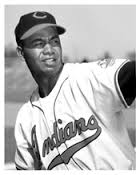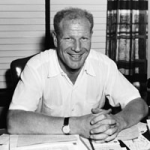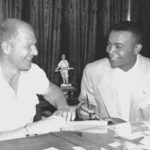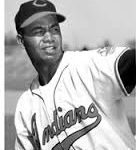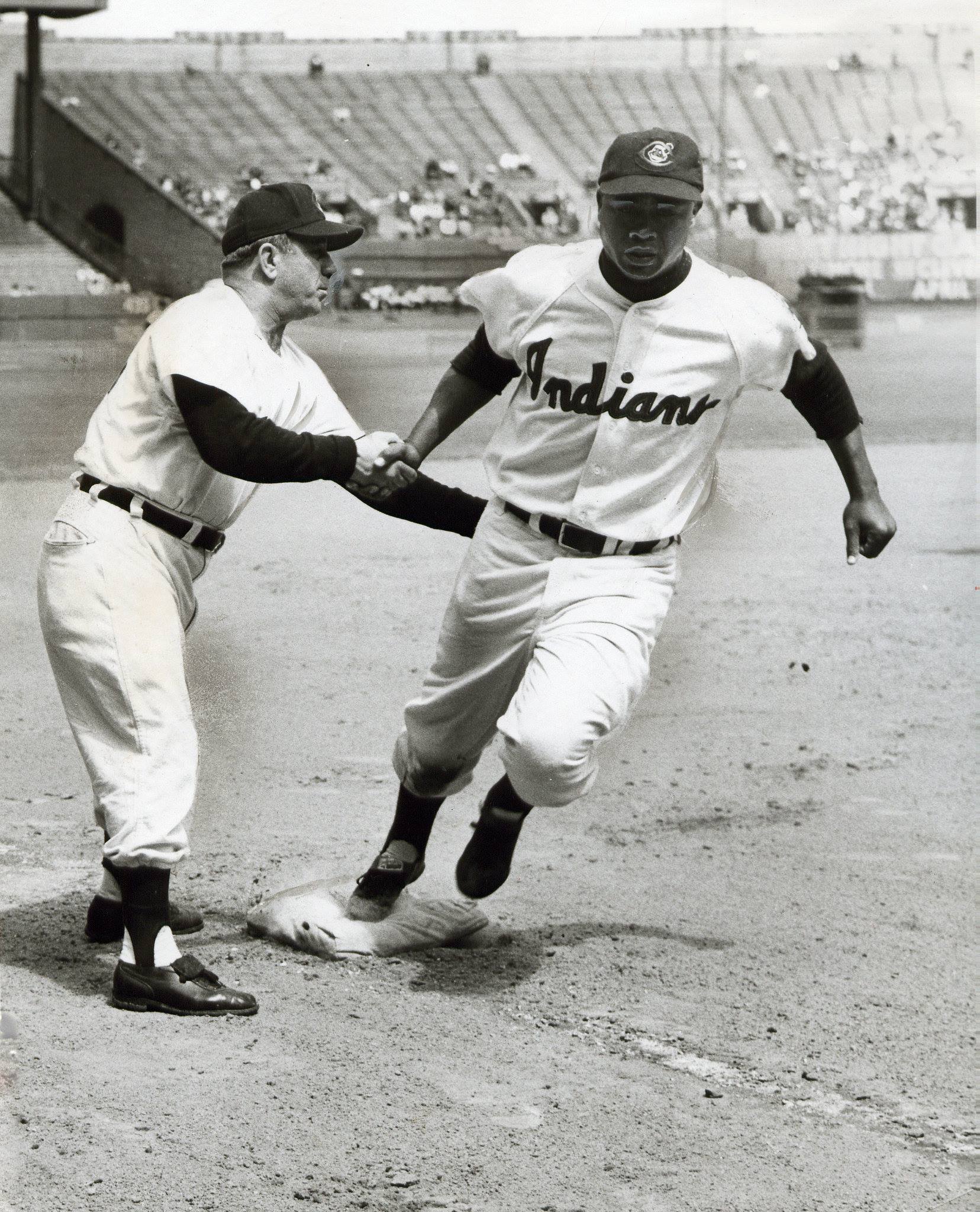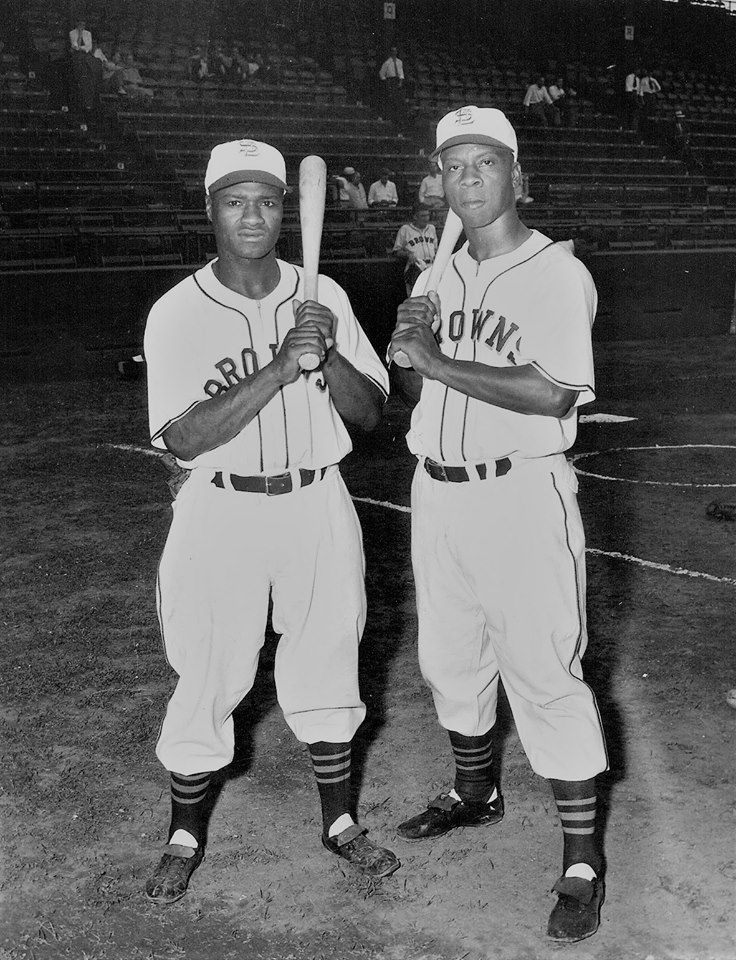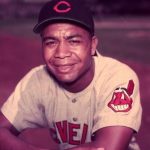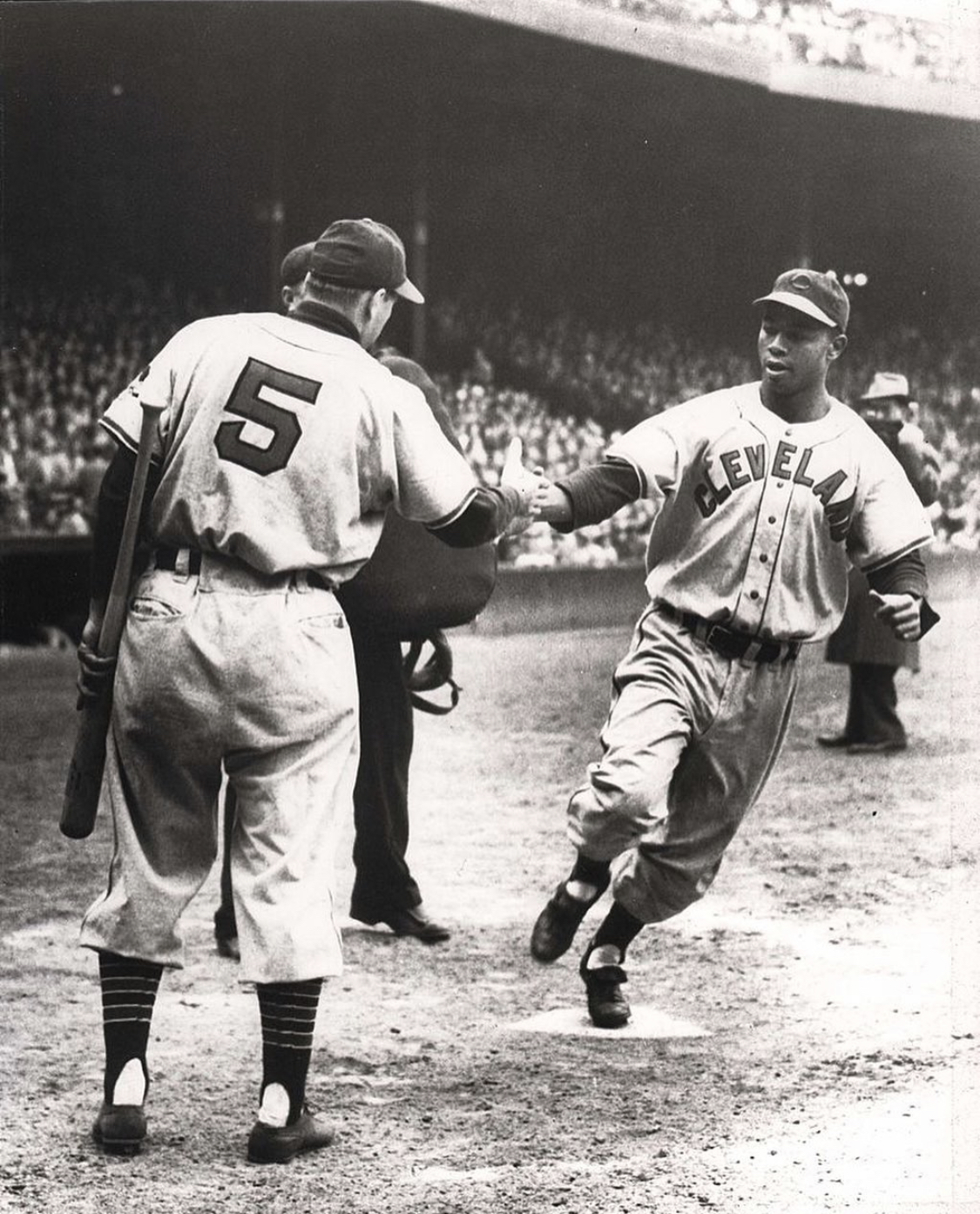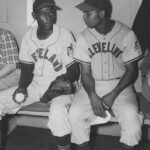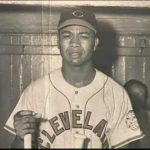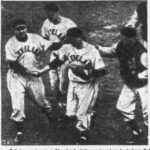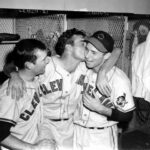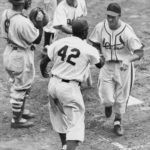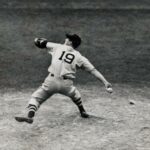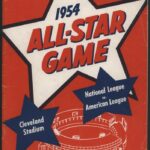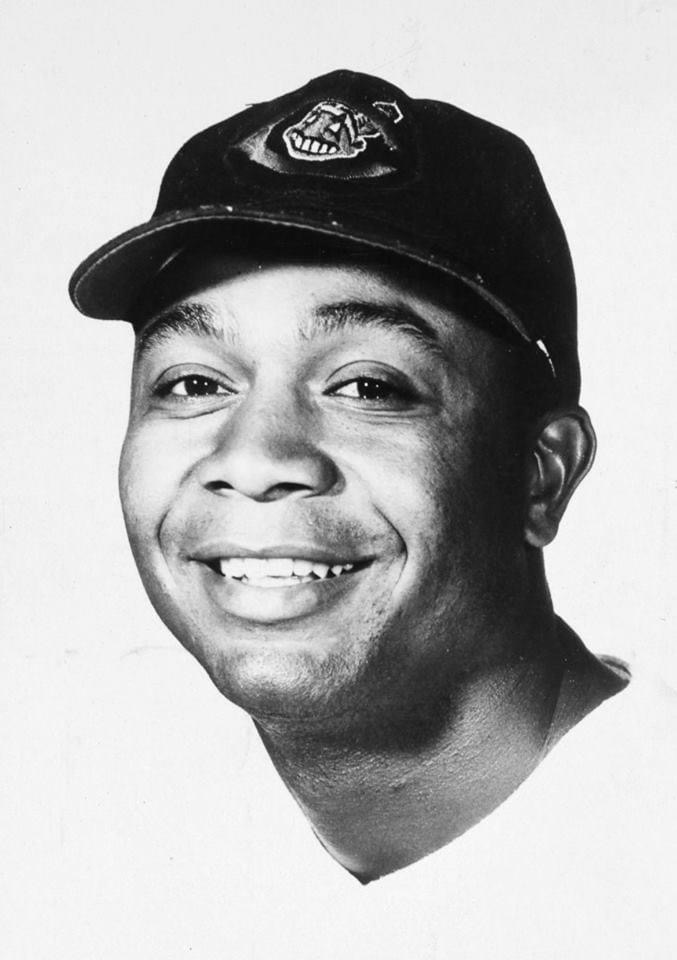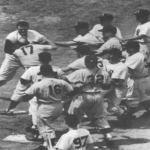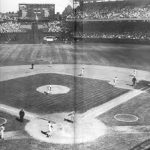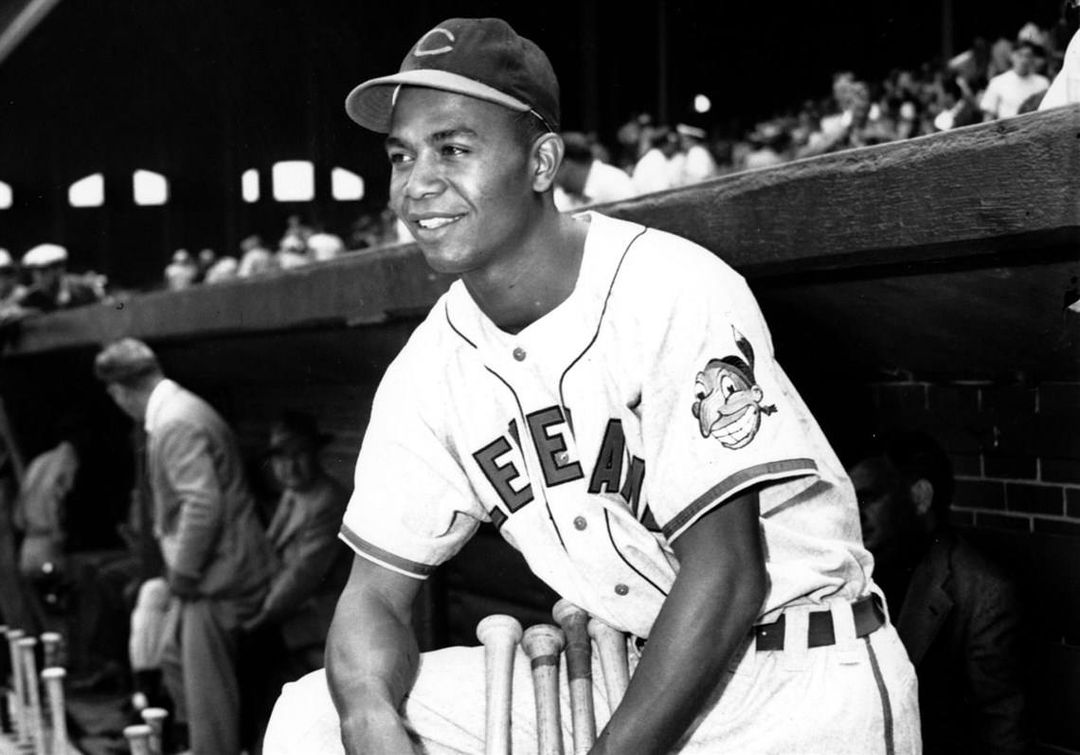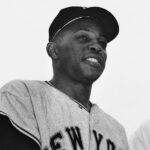Larry Doby Stats & Facts
Larry Doby
Positions: Centerfielder and Second Baseman
Bats: Left • Throws: Right
6-1, 180lb (185cm, 81kg)
Born: December 13, 1923 in Camden, SC us
Died: June 18, 2003 in Montclair, NJ
Buried: Cremated
High School: Eastside HS (Paterson, NJ)
School: Long Island University, Brooklyn Campus (Brooklyn, NY)
Debut: 1942 (9,149th in major league history)
AL/NL Debut: July 5, 1947
vs. CHW 1 AB, 0 H, 0 HR, 0 RBI, 0 SB
Last Game: July 26, 1959
vs. BAL 1 AB, 0 H, 0 HR, 0 RBI, 0 SB
Hall of Fame: Inducted as Player in 1998. (Voted by Veteran’s Committee)
View Larry Doby’s Page at the Baseball Hall of Fame (plaque, photos, videos).
Full Name: Lawrence Eugene Doby
Nine Players Who Debuted in 1947
Nellie Fox
Duke Snider
Larry Doby
Jackie Robinson
Curt Simmons
Mel Parnell
Vic Wertz
Ted Kluszewski
Ferris Fain
The Larry Doby Teammate Team
C: Jim Hegan
1B: Mickey Vernon
2B: Nellie Fox
3B: Al Rosen
SS: Lou Boudreau
LF: Minnie Minoso
CF: Jim Rivera
RF: Al Kaline
SP: Bob Feller
SP: Bob Lemon
SP: Early Wynn
SP: Billy Pierce
SP: Jim Bunning
RP: Satchel Paige
M: Al Lopez
Notable Events and Chronology for Larry Doby Career
Larry Doby
Just as Buzz Aldrin will always be remembered as the man who set foot on the moon after Neil Armstrong, Larry Doby has the fortunate, yet, unfortunate distinction of being the first African American to play in the major leagues after Jackie Robinson broke baseball’s color barrier in 1947. Though he was the American League’s first black player, breaking into the big leagues barely three months after Robinson’s historic call-up, Doby’s legacy will forever be obscured by that of his legendary predecessor.
That such is the case is tragically unjust, not only because Doby put up numbers that compare favorably with those of his NL counterpart, but more so because he had to suffer the same harsh treatment that Robinson faced, without receiving any of the publicity and subsequent acclaim. Doby weathered these indignities and hardships with inspiring grace and class, and thrived in spite of the turmoil, becoming a seven-time All-Star and one of the American League’s most feared sluggers. A half-century after he first blazed a trail for black American Leaguers, Doby was finally inducted into the Hall of Fame in 1998.
BIOGRAPHY
Larry Doby was born on Dec. 13, 1923, in Camden, South Carolina, though his family relocated to Paterson, NJ not long after his birth. The son of a semipro baseball player, Doby starred in three sports at Paterson’s Eastside High School before entering Long Island University. Having spent much of his youth in the integrated northeast, Doby was unprepared for the discrimination he would face in the world beyond. When he was inducted into the Navy in 1944, Doby was shocked and humiliated when he was segregated from the white inductees, many of whom he had known from the sandlots and ball fields of his youth.
After completing his military service, Doby joined the Newark Eagles of the Negro Leagues as a second baseman. In 1946, the left-handed slugger batted .341 and, alongside future Hall of Famer Monte Irvin, led the Eagles to the Negro League Championship. In doing so, he attracted the attention of Cleveland Indians owner Bill Veeck. Like Dodgers owner Branch Rickey, Veeck was determined to defy baseball’s unwritten rule barring black players. Following Rickey’s lead, Veeck signed Doby to a major league contract in 1947. After struggling in a mere 29 games that year, the young outfielder distinguished himself the following year with a .301 average for an Indians team that won 97 games and the AL pennant. But it was in the World Series that year that Doby broke out as a bona fide star, leading the team with a .318 Series average and crushing a game-winning, 400-foot home run off Boston Braves ace Johnny Sain in Game Four. The Indians went on to defeat the Braves in six games, capturing their first World Series title in almost 30 years.
The next year, Doby made the first of his seven consecutive All-Star appearances. Throughout the 1950’s, he excelled as one of the game’s most consistent run producers, and as one of its most formidable sluggers. Doby had perhaps his finest season in 1954, topping the American League with 32 homers and 126 runs batted in, and leading his Indians to a then-record 111 regular-season victories. In the World Series that year, the heavily-favored Indians squared off against the New York Giants. It was in this series that Doby unwittingly played a supporting role in one of baseball’s most famous plays. With the score tied 2-2 in Game 1, Doby walked to lead off the eighth inning, before advancing to second base on a single by Al Rosen. Vic Wertz followed with a booming drive to right center, a shot so deep, so certain to drive in Doby with the winning run, that Doby didn’t even bother to tag up before charging home. He had good reason to be so confident: the Giants’ young center fielder had been playing way too shallow to make a play on a ball hit so deep. Unluckily for Doby and the Indians, Willie Mays proved to be no ordinary center fielder, and the spectacular catch he made on Wertz’ drive has become one of the most famous plays in baseball history. Doby scrambled back to second base, just ahead of Mays’ powerful throw, and never scored. The Indians lost that game in extra innings and, unable to overcome the shock of that Game One loss, were swept by the Giants in four games. Doby averaged over 100 runs scored and 100 RBIs a season over the course of his 13-year career, which also included stints with the Chicago White Sox and Detroit Tigers.
After retiring in 1959, he became only the third major leaguer to play in Japan’s Nippon Professional Baseball League. He also later became a coach for the Indians and the Montreal Expos. In an ironic echoing of his groundbreaking achievement almost 30 years earlier, in 1978 Doby followed Frank Robinson as the second African American to manage in the major leagues when he took over as manager of the Chicago White Sox. In a further ironic twist, the man who hired him for the White Sox job was the same man who first brought him into major league baseball all those years ago – Bill Veeck.
Though one author once derided Doby’s place in baseball history as being akin to that of “the second man to invent the telephone”, the end of the twentieth century saw a reappraisal of the critical role Doby played not only in the game’s history but in our country’s history as well. When he was voted into the Hall of Fame in 1998, Doby viewed his legacy not through the prism of statistics, but rather in terms of what his experience could teach others about tolerance and unity. Before he passed away in 2003, Doby reflected on one of his favorite memories from his playing days: I hit a home run off Johnny Sain to help Steve Gromek win [Game 4 of the 1948 World Series], and in the clubhouse the photographers took a picture of Gromek and me hugging. That picture went all over the country. I think it was one of the first, if not the first, of a black guy and a white guy hugging, just happy because they won a ballgame. Larry Doby’s greatest contribution to baseball was not just to demonstrate that black players could play the game, but to prove that blacks and whites, and people of all races, could play the game together.
Quotes About
“I never asked a pitcher to knock him down. I’d tell him we might come inside because he doesn’t like the ball in there, but that was it. I always talked to players at the plate. He’d get tired of me asking about his family and say to the umpire, ‘Tell him my family’s fine and to shut up.’ ” — Yogi Berra
Best Season
It’s difficult to choose between these two seasons. Doby led the AL in OBP (.442) and OPS in 1950, batting a career-high .326 with a career-high .545 SLG mark and 110 runs scored. In ’54 he helped lead the Tribe to 111 season victories and the World Series, leading the loop in both homers (32), and RBI (126). Doby finished second to Yogi Berra in MVP voting in ’54, and a distant eighth in 1950 to Yankee Phil Rizzuto. It paid to be white and a Yankee in the 1950’s if you wanted to win an MVP trophy.
Factoid 1
Larry Doby was the first black player to play for a World Series champion in the major leagues.
@ET-DC@eyJkeW5hbWljIjp0cnVlLCJjb250ZW50IjoicG9zdF90YWdzIiwic2V0dGluZ3MiOnsiYmVmb3JlIjoiTGVhcm4gTW9yZSBhYm91dCB0aGUgdGVhbXMsIHBsYXllcnMsIGJhbGwgcGFya3MgYW5kIGV2ZW50cyB0aGF0IGhhcHBlbmVkIG9uIHRoaXMgZGF0ZSBpbiBoaXN0b3J5IC0gLSAtIC0gLSAtIC0gIiwiYWZ0ZXIiOiIiLCJsaW5rX3RvX3Rlcm1fcGFnZSI6Im9uIiwic2VwYXJhdG9yIjoiIHwgIiwiY2F0ZWdvcnlfdHlwZSI6InBvc3RfdGFnIn19@
Factoids, Quotes, Milestones and Odd Facts
Played For
Cleveland Indians (1947-1955)
Chicago White Sox (1956-1957)
Cleveland Indians (1958)
Detroit Tigers (1959)
Chicago White Sox (1959)
Managed
Chicago White Sox (1978)
Doby was the second black manager in Major League history, following Frank Robinson.
Similar: Kirk Gibson, David Justice
Linked: Jackie Robinson, Monte Irvin, Frank Robinson… Billy Goodman and Mickey Vernon were two of Doby’s best friends in the major leagues. Doby also enjoyed a long friendship with Yogi Berra… Doby was a roommate of Satchel Paige.
Best Season, 1950
It’s difficult to choose between these two seasons. Doby led the AL in OBP (.442) and OPS in 1950, batting a career-high .326 with a career-high .545 SLG mark and 110 runs scored. In ’54 he helped lead the Tribe to 111 season victories and the World Series, leading the loop in both homers (32), and RBI (126). Doby finished second to Yogi Berra in MVP voting in ’54, and a distant eighth in 1950 to Yankee Phil Rizzuto. It paid to be white and a Yankee in the 1950’s if you wanted to win an MVP trophy.
Post-Season Appearances
1948 World Series
1954 World Series
Factoid
Larry Doby was the first black player to play for a World Series champion in the major leagues.
Where He Played: Like Jackie Robinson and many other Negro league stars, Doby was asked to change positions in the major leagues. He was a middle infielder, but since the Indians had Lou Boudreau and Joe Gordon, Doby became an outfielder. When Doby reported to the Indians, four of his new teammates refused to shake his hand. Ironically, one of the friendliest players was Gordon, who played the same position as Doby. Initially, Cleveland tried Doby at first base, but as teammate Bob Feller explained, Doby could play the position “no better than my sister.” Doby eventually became an All-Star center fielder.
Big League Debut: July 5, 1947
Doby debuted about three months after Jackie Robinson re-integrated the major leagues. When Doby reported to the Indians, he was greeted warmly by many of his new teammates, but a few,including first baseman Eddie Robinson, refused to shake his hand.
Post-Season Notes
A famous photo from the 1948 World Series shows Doby and winning pitcher Steve Gromek in an embrace after Game Four. It caused a minor stir at the time, since Gromek, a white man, was cheek-to-cheek with his black teammate. Bob Feller is quoted as saying “whoever took that photo should have won the Pulitzer Prize.”
Milestones
Doby was a major league caliber player at the age of 20, and had he been able to play in the big leagues at that age, he probably could have reached the 400-homer mark.
Hitting Streaks
21 games (1951)
21 games (1951)
Transactions
October 25, 1955: Traded by the Cleveland Indians to the Chicago White Sox for Jim Busby and Chico Carrasquel; December 3, 1957: Traded by the Chicago White Sox with Jack Harshman, Russ Heman, and Jim Marshall to the Baltimore Orioles for Tito Francona, Ray Moore, and Billy Goodman; April 1, 1958: Traded by the Baltimore Orioles with Don Ferrarese to the Cleveland Indians for Gene Woodling, Dick Williams, and Bud Daley; March 21, 1959: Traded by the Cleveland Indians to the Detroit Tigers for Tito Francona; May 13, 1959: Purchased by the Chicago White Sox from the Detroit Tigers.
Quotes About Doby
“I never asked a pitcher to knock him down. I’d tell him we might come inside because he doesn’t like the ball in there, but that was it. I always talked to players at the plate. He’d get tired of me asking about his family and say to the umpire, ‘Tell him my family’s fine and to shut up.’ ” — Yogi Berra
All-Star Selections
1949 AL
1950 AL
1951 AL
1952 AL
1953 AL
1954 AL
1955 AL
Replaced
Catfish Metkovich, as the Indian center fielder.
Replaced By
Cleveland acquired Jimmy Piersall after the 1958 season, and he replaced Doby in center field the following year.
Best Strength as a Player
Combination of power and speed.
Largest Weakness as a Player
Doby was not a good base stealer.
Other Resources & Links

